How to build a cesspool in a private house: overview of structures + rules for their arrangement
If a person lives in a house, it must have a sewer system, since waste products still need to be removed somehow.And it’s hard to disagree with this, isn’t it? Modern industry offers many solutions: from multi-section septic tanks to neat dry closets. But an ordinary cesspool in a private house is still relevant and in demand.
But, before you start building a cesspool on your site, you will have to weigh the pros and cons. After all, an incorrectly chosen location, and the design of the cesspool itself, subsequently threatens to result in many problems. The most common of them is the appearance of an unpleasant odor. We will tell you how to avoid this problem.
In the article we collected and summarized information about the types and design features of cesspools. In addition, here you can find useful tips and recommendations on how to choose and build a sewer system on your site. The material is accompanied by thematic photos and videos.
The content of the article:
Design and design types
A cesspool is perhaps the oldest and simplest type of sewage system. It is a depression in the ground in which wastewater is accumulated and partially processed.
Any wastewater contains a certain amount of bacteria that absorb and transform these accumulations. Part of the filtered wastewater passes into the underlying soils.
Everything that has not been processed and has not gone into the underlying layers should be periodically removed from the cesspool so that the container does not overfill.
At summer cottages, a separate cesspool for the toilet is often installed. It looks like a relatively small depression in the ground, over which a light wooden structure is installed.
When the hole is full, the toilet is removed and the hole is filled with earth. Waste rots in the soil and turns into compost, a useful fertilizer.
In the future, a fruit tree is planted in this place, which will give an excellent harvest in such a well-fertilized place. And for the toilet, they dig a new hole, which is subsequently disposed of in a similar way.
But for the needs of a large house, especially for year-round living, such a solution, of course, is not enough.
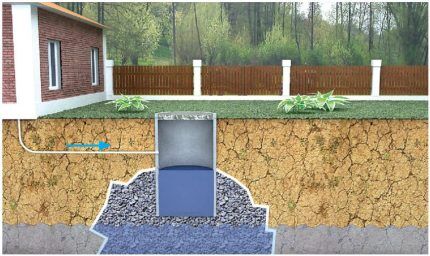
Modern cesspools have a fairly large volume, and their walls are constructed from a variety of materials.
It could be:
- brick;
- aerated concrete blocks;
- wood;
- concrete rings;
- old tires, etc.
To construct a simple cesspool, you can now purchase a ready-made plastic container with hatch and strong walls.
With its help, the process of constructing a mini-sewage system in a suburban area is significantly simplified and accelerated significantly.
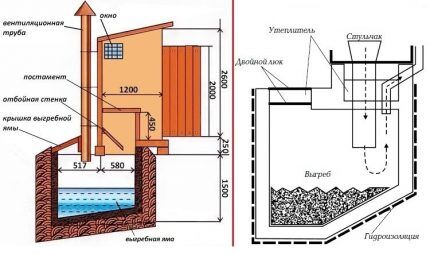
When choosing material for a cesspool, it should be taken into account that prolonged contact with an aggressive environment will gradually destroy its walls.To extend the life of the structure, you need to choose materials that are resistant to such impacts.
There are two types of cesspools: sealed And filtering. In the first, wastewater is accumulated and stored until pumped out. Secondly, there is no bottom in the traditional sense of this term, and there may be holes in the walls so that some of the waste enters the ground.
If filtration of wastewater through the walls of the structure is expected, then a gravel-sand filter with a thickness of at least 15 cm is installed around them.
Walls filter structure They are made either monolithic or perforated, depending on the filtration qualities of the surrounding soil and the tasks of wastewater treatment.
Structures with the possibility of infiltration into the surrounding soils are installed primarily for wastewater collected by drainage and storm sewers. Between the conditional bottom of such a structure and the groundwater surface there must be a soil thickness of at least 1 m thick.
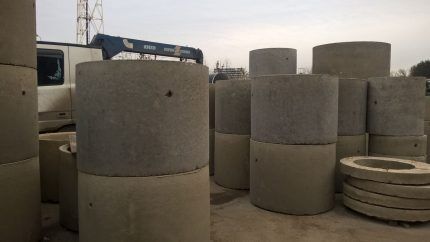
A cesspool with a sealed bottom and monolithic walls is installed for the collection and subsequent removal of domestic and utility waste.
It is also needed when the groundwater level is high, because in such situations it is necessary to exclude direct communication of wastewater with the environment.
Large-volume cesspools, in which large amounts of waste are expected to accumulate in a short time, must also be sealed. A significant amount of waste will take too long to process, increasing the risk of soil contamination.
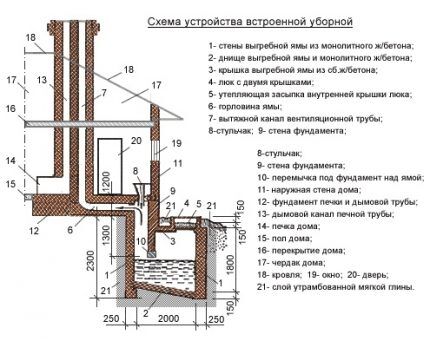
Design and Preparation Principles
Even such a simple structure as a cesspool requires proper preparation and planning. It is necessary to determine a suitable location for its arrangement, select the type of structure, its dimensions, work technology, materials, etc.
The location of the cesspool is the most important point. According to building codes, it must be located at a distance from fences, residential buildings, etc.
For example, this sewerage structure must be located at least 25 meters from a well with drinking water, and at least five meters from a residential building.
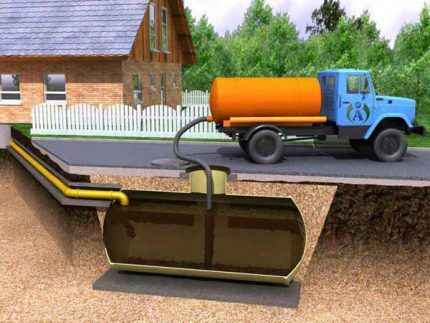
If the terrain on the site is uneven, you should not install a cesspool in a low area. During the spring flood, it is highly likely to be flooded, and this will lead to contamination of groundwater in the area.
The volume of the structure depends on the number of residents in the house and the length of stay. For one person they usually take from 0.5 to 2.0 cubic meters. m.
It is better if the volume of the structure is a multiple of the capacity of the sewer truck, since the fee for using the equipment usually does not depend on the amount of waste, the cost of each trip is paid.
When thinking about a place to place a cesspool, you should immediately take care the problem of cleaning it. The easiest and fastest way to perform this unpleasant procedure is to use a vacuum cleaner. Therefore, sufficient space should be provided for the passage of such equipment.
It also happens that the area for a cesspool that complies with the standards does not allow the use of a sewer truck. In this case, accumulated wastewater is removed using a special pump or an ordinary bucket.
The pit is made airtight or with holes for filtering. The choice is influenced by the groundwater level at the site. If it is less than a meter, the pit must be completely sealed.
Otherwise, runoff may penetrate into the aquifer and negatively affect water quality.It will not be easy to restore its normal composition in such a situation.
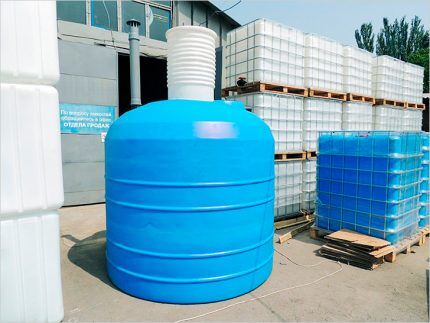
To create a sealed cesspool, the bottom is concreted and the walls of the structure are made without gaps. An alternative option is a plastic container installed inside the pit.
It will also provide the necessary tightness, but it should be remembered that the strength of plastic is significantly inferior to concrete or brick.
If the first aquifer from the surface lies 1 meter or more below the bottom of the pit being constructed, then it can be constructed according to the principle of a filter or absorption well.
The bottom of the pit is formed from material with high filtration properties: sand, crushed stone or gravel with sand filler. The thickness of the filter bed is at least 1 m.
There is no point in installing a filter structure on rocky and semi-rocky rocks, loams and clays, because processed wastewater simply will not be able to migrate further into the ground.
It is also not done if there is a possibility of unloading into open water bodies near swimming areas or points of water intake for technical purposes.
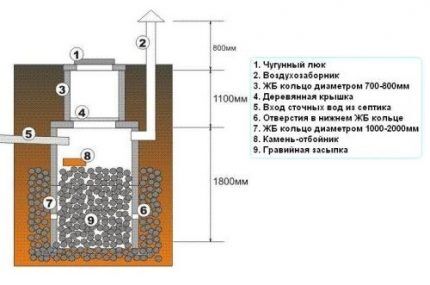
For a small family of three people, there are folk standards for constructing cesspools. Arrange them at the rate of 0.5 m3 per person, with an average depth of 1.0 - 1.5 m, width 0.8 - 1.0 m.
If a small-sized closet rises above the cesspool for summer residents who do not permanently live in a suburban area, the standard dimensions and estimated volume can be slightly reduced.
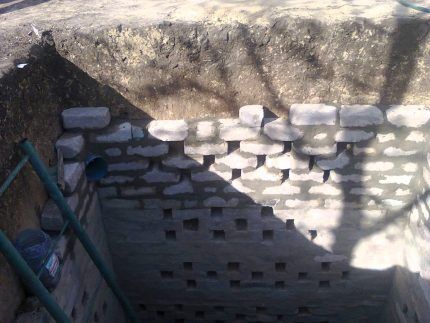
Features of installation of cesspools
So, the place has been chosen, it’s time to start building the foundation pit. Usually, special equipment is used for this, since removing large volumes of soil manually is too time-consuming and difficult. The pit configuration can be square, rectangular, round - it all depends on the chosen material.
Under old tires, concrete rings and so on. you will need a round pit.
It is more convenient to pour concrete or erect wooden walls in a square or rectangular hole. And here brickwork can be done in a circle or in a straight line.
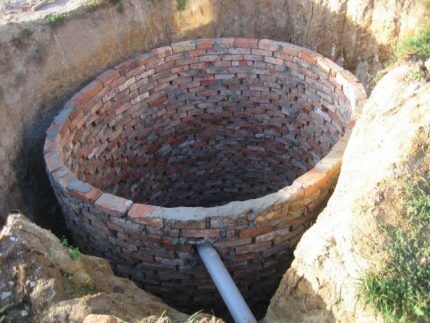
After the pit is ready, you need to start arranging a bottom filter from a compacted mixture of crushed stone and sand. Over time, crushed stone is added to the pit if part of the filter material is squeezed out under the weight of the wastewater into the underlying layer.
If you need a sealed pit, the bottom is made in the form of a concrete screed, just like for a foundation. Then the walls are built. You can continue working with concrete, making formwork and pouring the walls.
It’s easier and faster to make a sewer system from concrete rings.They are installed in the pit, and then the seams are sealed and sealed.
The plastic container is placed on a compacted sand cushion. In this case, backfilling the pit should be done very carefully so as not to damage the plastic. It is recommended to simultaneously pour water into the container to balance the pressure outside and inside.
There are no particularly strict requirements for the quality of brickwork in a sewer structure; the result will be hidden underground. This work can easily be entrusted to a novice mason.
But you should still remember that even in a sewer, walls that are too crooked are not needed. This increases the likelihood of their destruction under the influence of external factors.
Ordinary brickwork will provide sufficient tightness to the structure. If it is planned to create a cesspool with natural filtration, a gap of approximately half a brick is left at the joints.
In agreement with local inspection structures, in rare cases it is permissible to build a cesspool made of wood. It is recommended to pre-treat wood with special materials to increase its service life.
As practice shows, wooden cesspools do not last long and may need repair after a few years.
To make the cracks between the logs waterproof, they caulk and tar, and a waterproofing layer of clay 45 cm thick is applied to the bottom and walls. The cesspool is covered with tightly packed logs on top, and a hatch of approximately 80x70 cm is installed to allow drainage to be pumped out.
And another option for finishing the walls of a cesspool is old tires. They are stacked in a pit to protect the walls of the pit from destruction.Of course, we are not talking about any special tightness in this case.
This is a temporary option that does not provide a large volume for the accumulation of wastewater. But making a tire pit is relatively easy, and it performs its functions quite satisfactorily.
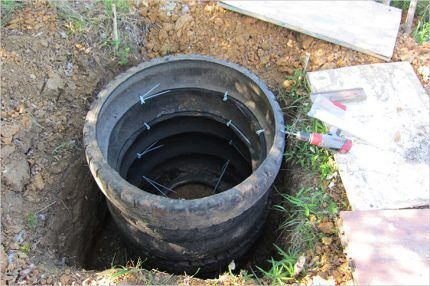
The nuances of operating cesspools
If the cesspool is constructed correctly, there will be no major problems with its operation. The main problem is regularly cleaning the container from accumulated waste. You should not wait until the container is full; you should start removing wastewater earlier.
However, simply pumping out sewage does not automatically make the structure clean. In cesspools, over time, phenomena such as silting of the bottom and contamination of the walls with fatty deposits are observed.
All this leads to a reduction in the volume of the structure, it fills up faster, and sewer trucks have to be called more often.
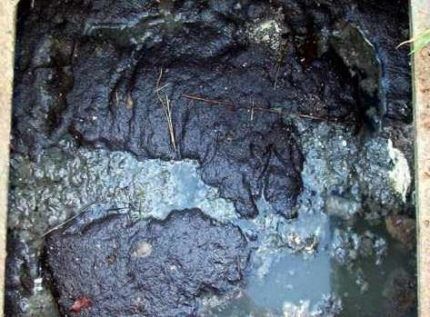
In addition, pollution intensifies the already unappetizing aromas characteristic of sewers. One way to solve the problem is to use special bacteria for cesspools. These microorganisms are simply poured into a container in accordance with the manufacturer's instructions.
The presence of bacteria helps speed up the processing of wastewater and prevents the possibility of contamination of the surrounding soil. In addition, microorganisms can significantly weaken and even completely eliminate unpleasant odors of sewage.
Before using bacteria, you should carefully study the instructions. Such preparations are not always compatible with some types of household chemicals. You need to choose a different composition or change products for cleaning, washing and other needs to more suitable ones.
Sometimes bacteria don’t help either, and the walls and bottom of the container become covered with deposits. In this case, mechanical cleaning of the container will help. After pumping out the wastewater, a worker descends into the pit to clean the dirt from the walls.
Then a layer of sludge is removed from the bottom. The cleaned bottom should be covered with a fresh layer of crushed stone or gravel.
The work of cleaning cesspools is not only labor-intensive, but also dangerous. They should be performed in special protective clothing and a respirator. Safety glasses and, of course, gloves will also help. It is not recommended to perform such work alone.
Sediments can release gases that are hazardous to human health. A worker inside the pit may suddenly lose consciousness due to exposure to such fumes. Even if there are two or three people working below, they should be insured by someone on the surface in case of such trouble.
Cesspool made of concrete rings
The use of ready-made reinforced concrete structures, in this case concrete rings, significantly speeds up construction, which is why they are used quite often. Such elements can be used to create both a sealed and absorbent cesspool.
In the first case, monolithic rings are used, and in the second, special rings with holes are used.
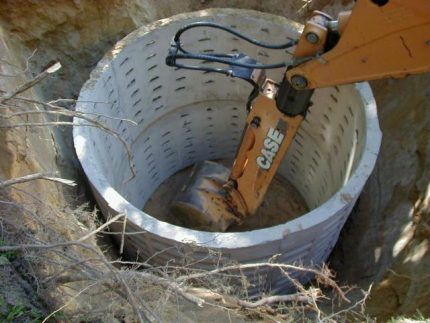
Of course, intact elements without cracks should be used so that the structure does not fall apart during operation.
To make a cesspool from concrete rings, follow these steps:
- Choose a location for the construction.
- Make markings.
- Dig a pit.
- Level the bottom.
- Fill the bottom of the hole with concrete screed.
- Install concrete rings.
- Lay the necessary sewer pipes.
- Seal the seams.
- Carry out waterproofing and sealing work.
- Backfill the pit.
- Install a concrete slab with a hole and a cover.
- Install ventilation structures.
Of course, for an absorption cesspool there is no need to concrete the bottom. Instead of a screed, a layer of gravel or crushed stone should be placed on the bottom to improve the drainage of the structure. And for a sealed structure, you can find a ready-made concrete ring that already has a bottom. But such options are not common.
The bottom is concreted using a screed about 10 cm thick. To give the layer additional strength, crushed stone is added to the composition. the solution should be as homogeneous as possible to achieve uniform drying.
Until the screed dries, it is impossible to continue work on arranging the cesspool. You'll have to wait at least a week. After drying, flaws may appear on the screed - cracks, unevenness, etc. They must be removed using a special repair solution.
Concrete rings should be installed very carefully. This can be done using a crane or manually. The connections are sealed using rubber gaskets; you can use old car inner tubes. At the joints, the rings are insulated using a solution.
From the inside cesspool waterproofing It is recommended to use liquid glass.
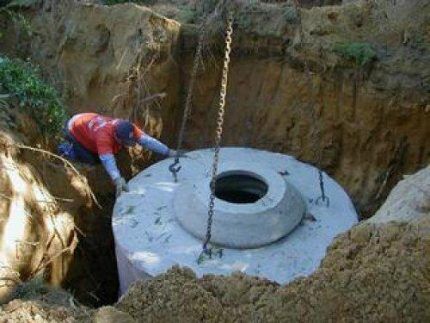
For laying sewer pipes dig a trench with a slight slope - about 3 degrees. The recommended depth of such a trench is at least one meter so that the pipes do not freeze in winter. For the same purpose, the pipes are covered with a layer of heat-insulating materials.
A hole in a concrete ring for connecting a sewer pipe can be made using a hammer drill.
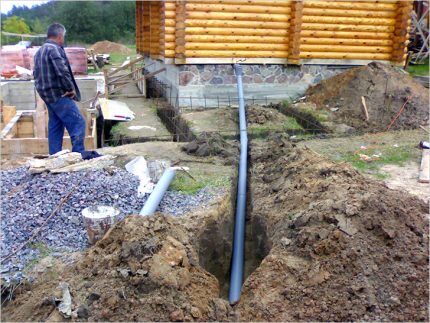
After the pipes are laid, the quality of the work is checked by flushing some water down the drain. Once you are sure that there are no leaks, you can begin backfilling the trench. A reinforced concrete slab is usually used as the top floor.
It is best to choose a design that already has a round or square hole for maintenance. This hole is closed with a standard lid.
Good ventilation of the cesspool helps improve waste processing and remove unpleasant odors. For ventilation, you must make a special hole in the upper ceiling and bring the pipe up.
A plastic pipe with a diameter of at least 100 mm is suitable. It must be covered with a special deflector on top to prevent precipitation from penetrating into the wastewater.
Conclusions and useful video on the topic
Here is a detailed overview of the design of cesspools made of various materials:
An interesting version of a cesspool lined with brick is presented in this video:
In this video you can see a clear example of installing a cesspool made of concrete rings:
A cesspool is an ancient structure, but useful. This is the simplest and relatively cheap way to provide your home with a reliable independent sewerage system..
You just need to choose the right place, decide on the volume and strictly follow the technology of work.
Do you know the secrets of arranging an autonomous sewer system with a cesspool? Perhaps you recently built a sewage storage tank with your own hands from scrap materials? Tell us about it - your experience may be useful to other country home owners.




I didn’t bother at all at the dacha: I dug a hole, built a wooden hut and that’s it - the toilet is ready. But when my parents bought a house, I took this issue more seriously from them. They dug a wide pit and ordered concrete rings. We installed everything and built a toilet. A couple of times a month a car comes and sucks everything out. It’s cheap and cheerful, and I don’t see any reason to unnecessarily complicate this system.
I dug a hole not for a street toilet, but as a filter well for gray sewerage. There was a toilet with a cesspool in the house; it was necessary to dispose of dirty water from the kitchen, sinks and shower. I simply ran a wide plastic pipe from the house into the pit at a slight inclination towards the drain. I was lucky that I dug down to the sand, which began to absorb all the waste, so I have to clean the hole much less often.
The absorption pit itself is about five meters deep and 1.5 by 1.5 meters wide. And on top I knocked down a wooden frame and covered the entire system with ordinary wavy slate.It’s quite a practical option; I look there from time to time to check when it’s time to remove the sediment that has settled on the ground filter.
Isn't your hole too deep? Five meters only for gray waste, how many people is this designed for? I just also need to dig a hole at the dacha to drain household waste, but I planned on a meter and a half maximum.
Hello. In general, most sewage disposal machines do not reach wastewater from a depth of more than 3 meters.
Daniil was lucky with sand and, in addition, he does not drain solid waste, which silts up the bottom and does not allow water to pass through. In shallower pits, the sludge can be cleaned, but you will have to rake out the drains with a machine, and then add chemicals for decomposition; natural microorganisms do not grow in pits with a high content of cleaning agents. Again, in terms of depth, whether the machine will pump out this sludge (you need to check the equipment with local sewage specialists).
In general, there are many calculations and standards on this topic. For example, it is recommended to make pits with a volume of 2 cubic meters per person, while if filled by more than a cubic meter per day, according to SNIPs, it is necessary to equip two-chamber pits.
Also, the distance from the bottom of the pit to groundwater must be at least a meter.
My friends have a drainage hole of 3 meters, one and a half by one and a half. There are 5 people in the family, three of whom are children. Complex pit for liquid and solid waste. The sludge was pumped out 4 years after construction using a sewer truck. This is taking into account that the soil at this depth is rich clay. It is difficult to say which pit is right for you; here you need to take into account the number of drains per day, the type of soil, and so on.
Standards SanPiN 42-128-4690-8
The wastewater storage tank must be located in the area immediately adjacent to a private house
the distance from the cesspool to the water supply must be at least 10 meters
place a storage or treatment facility no closer than 10 meters to your residential building and residential buildings located in the neighboring territory
the distance from the system to the fence delimiting two plots of land should not be less than 2 meters
The depth of the cesspool according to SNiP cannot exceed 3 meters
Is it possible to dig 2 holes for one house?